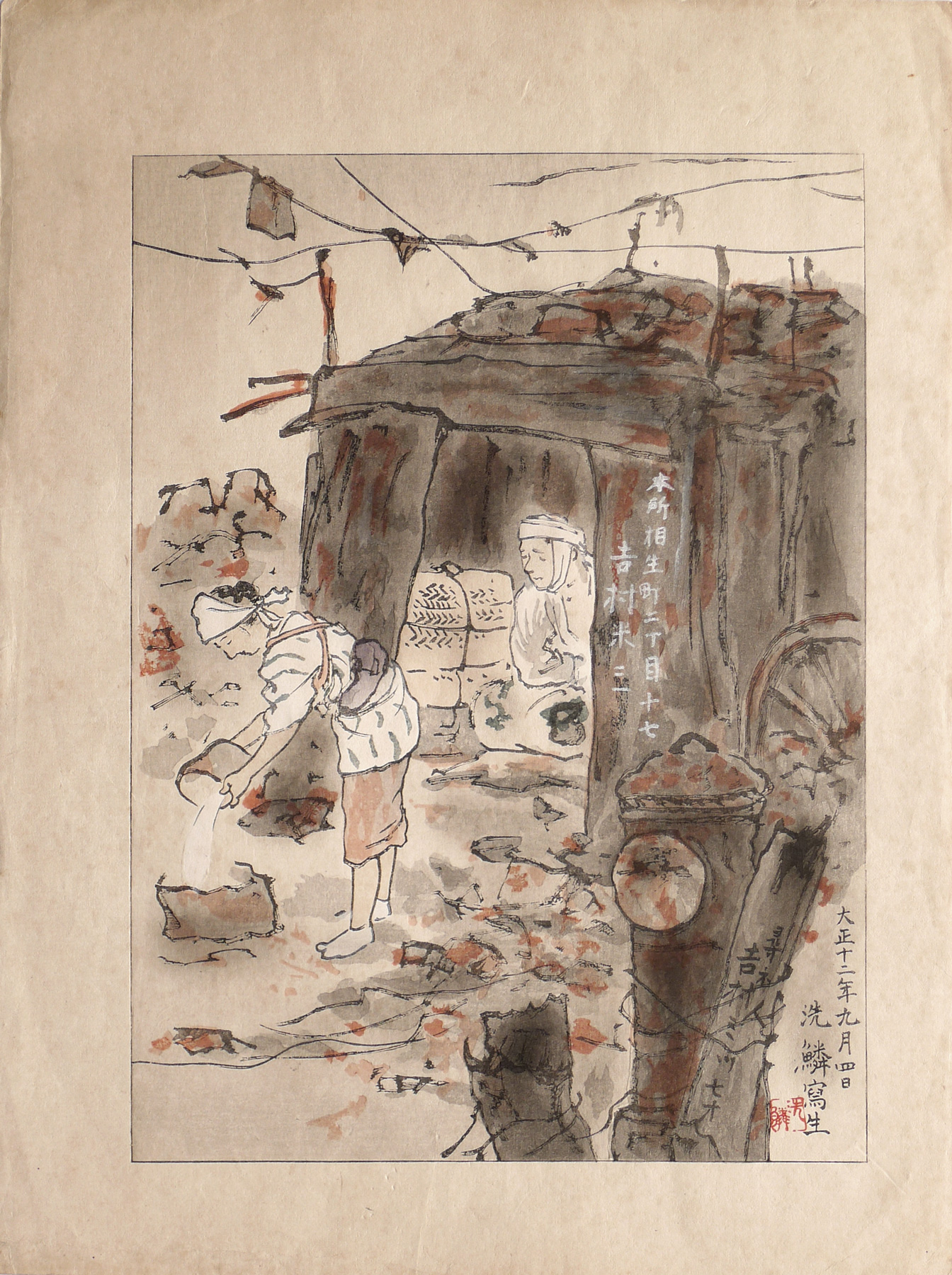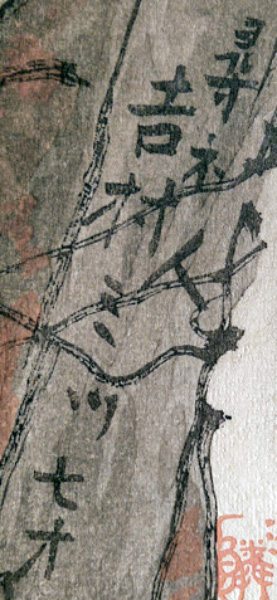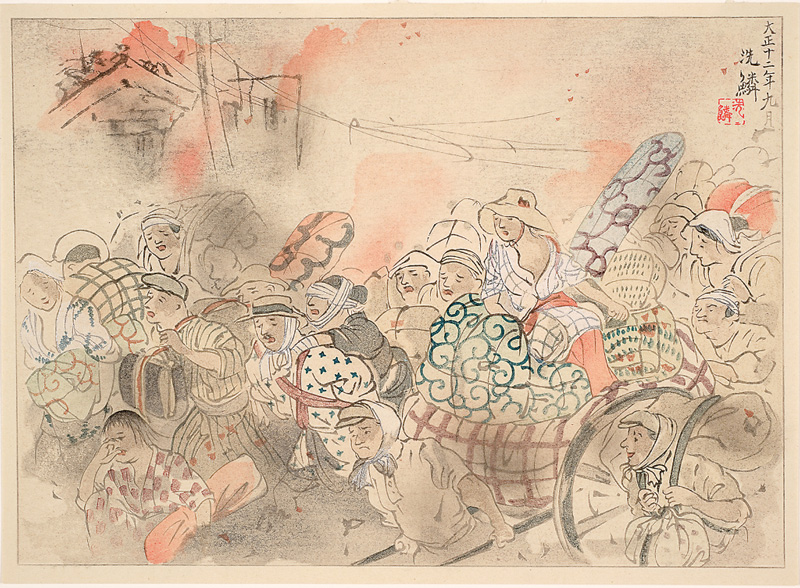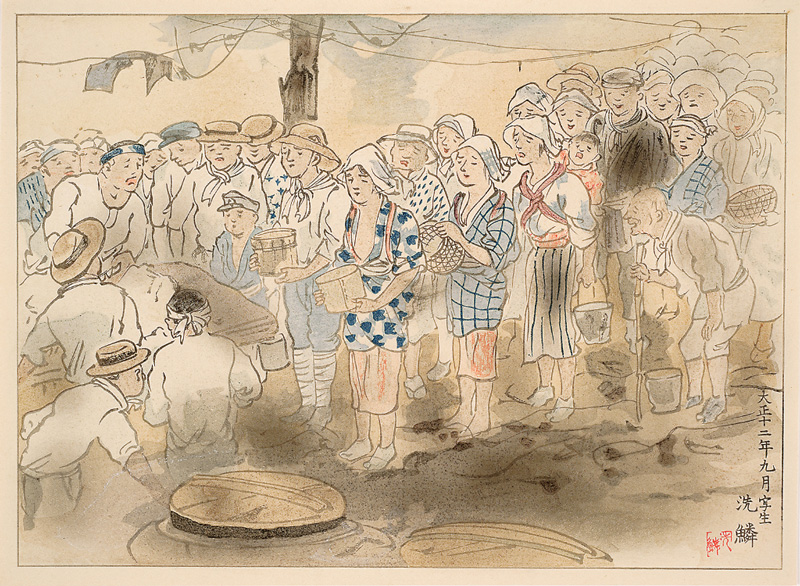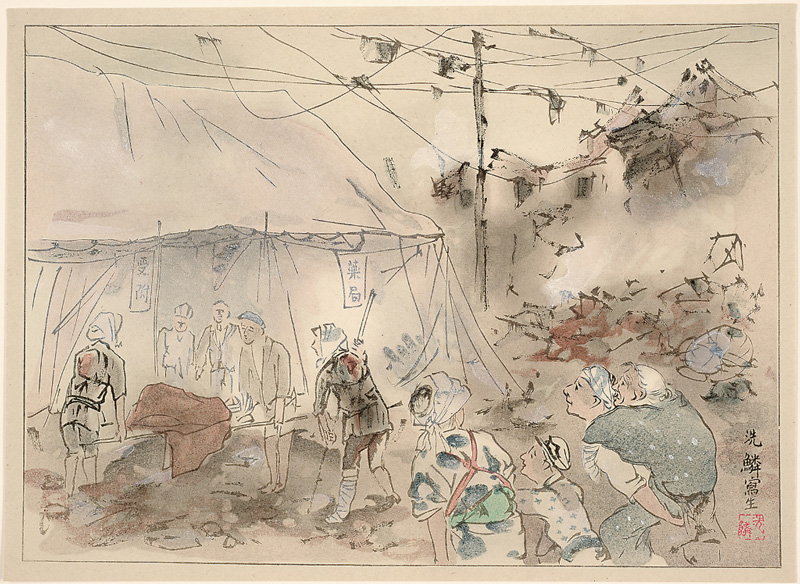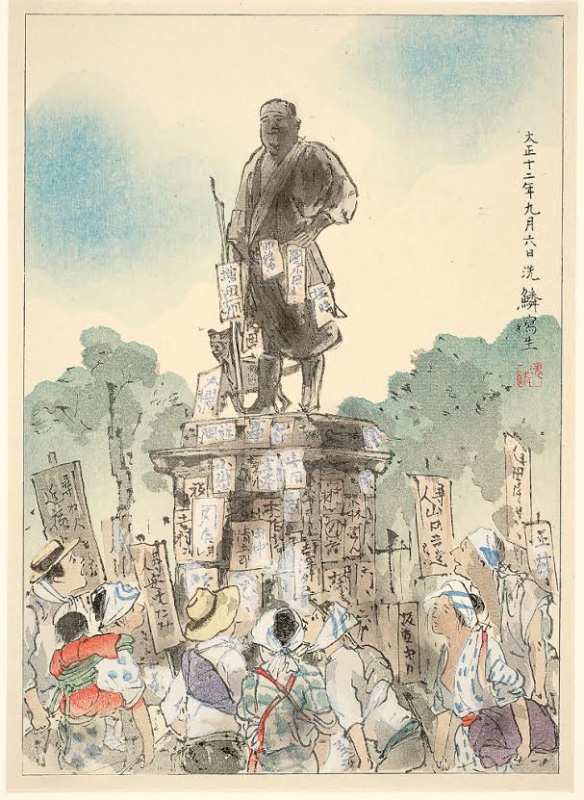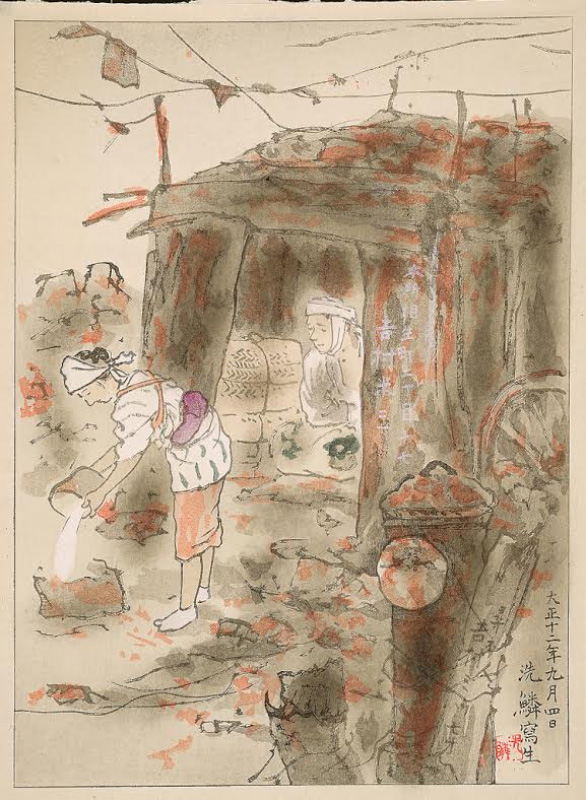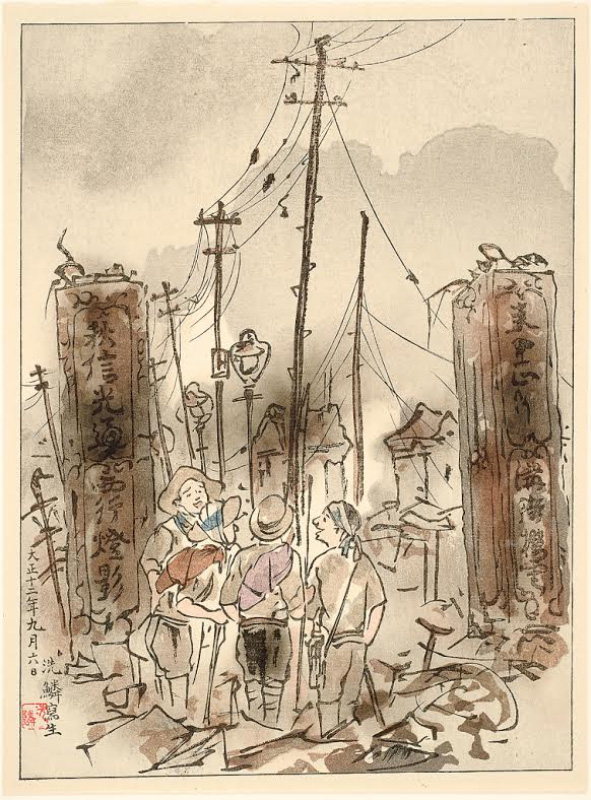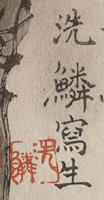About This Print
One of six prints contributed by Senrin to the 1924 thirty-six print series Collection of Woodblock Prints of the Taishō Earthquake issued by the publisher Gahōsha.
1 The Artist's Touch, The Craftsman's Hand: Three Centuries of Japanese Prints from the Portland Art Museum, Maribeth Graybill, Portland Art Museum, Oregon, 2011, p. 292.
detail of writing on doorway本所相生町二丁目十七
[Honjo aioi machi ni chōme jū nana]
吉村米二一
detail of message on sign board尋ね人
[missing person]
吉村ミツ七十
[Yoshimura Mitsu, 70]
About The Series Collection of Woodblock Prints of the Taishō Earthquake
This series of thirty-six prints was issued by the publisher Gahōsha, located in Hongō, Tokyo, "in installments of three prints per month during the entire year of 1924. The price for one installment was 1 yen 50 sen, and the price for a yearly subscription was 17 yen." The thirty-six prints were divided into two series, titled "Series I" and "Series II."1 Imaging Disaster: Tokyo and the Visual Culture of Japan's Great Earthquake of 1923, Gennifer Weisenfeld, University of California Press, 2012, p. 312, f.n. 23.
Commentary on the Series by the Portland Art Museum
Source: The Artist's Touch, The Craftsman's Hand: Three Centuries of Japanese Prints from the Portland Art Museum, Maribeth Graybill, Portland Art Museum, Oregon, 2011, p. 292.
The Great Kantō Earthquake of 1923 stands in memory as one of the most terrifying calamities in Japanese history. Registering at a magnitude of 7.9, the quake struck on September 1, with its epicenter some 50 miles southwest of Tokyo in Segami Bay. The hour was 11:58A.M., just when households everywhere were lighting small charcoal stoves to prepare lunch. Fires broke out instantly in the densely populated cities of Tokyo and Yokohama and were spread by high winds. Since the earthquake had broken the water lines, both cities were reduced to smoldering ruins within a few hours. The neighboring prefectures of Chiba, Kanagawa, and Shizuoka suffered heavy damage as well, with landslides, upheavals, and cracks in the earth's surface. The quake and its aftermath caused well over 140,000 deaths and left nearly 700,000 people homeless.1
In 1924, the Japanese publisher Hoshino Seki [of the publishing house Gahōsha] issued a set of thirty-six prints depicting scenes from the aftermath of the September 1, 1923 great Tokyo earthquake. He commissioned six artists to each produce six designs based on eye witness sketches and accounts, which the master carver Nagashima Kiichi and printer Tamura Tetsunosuke then translated into color woodblock prints for the portfolio.
The thirty-six prints in this series were designed by six men who had established reputations as Nihonga painters; three of them were graduates of the Tokyo Art School (the forerunner of Tokyo University of the Arts), and several of them participated in the Bunten and Teiten exhibitions.2 The prints were offered on a subscription basis and were issued in twelve groups of three in 1924. The publisher charged 1 yen 50 sen for each packet of three prints, with a discount price of 17 yen for those who paid for all thirty-six prints in advance. According to research by Donald Jenkins, the price works out to about twenty-five cents per print in contemporary U.S. dollars, or the price of two cans of soup.3
Little is known about the publisher, Gahōsha, apart from a lengthy statement about the aims of
the project in the pre-publication announcement.4 The document is fascinating in the way it
frames the publisher’s aims:
Nature always regards humankind with a stern attitude. At times, it unleashes violence, and all too often humans and their works are destroyed. Yet, for all its severity, Nature is not without empathy. Its warm affection is a wellspring of benevolence, sufficient to comfort our hearts. ... Those who recently personally experienced the great earthquake disaster ... do not have the wherewithal to reflect on Nature’s blessings, but I believe that it is the duty of artists to shower us with Nature’s affectionate waters.
With that thought in mind, and determined to offer a small gesture of social service, our firm solicited from energetic, up-and-coming painters active in leading artist organizations thirty-six pictures dealing with the earthquake disaster, which we will distribute as woodblock prints.... [Woodblock printing has recently experienced a revival and new artists have emerged.] However, their work is not yet widely distributed, because the cost of producing woodblock prints is so high. [We] have sought out a first-rate carver and printer and selected the finest paper and pigments, anticipating results that will make a convincing case for woodblock prints as the people’s art (minshuteki geijutsu). We are offering [this series] for an extremely modest price. We do so with no thought for profit, but only in the hope of fostering the revival of artists’ groups, and ask for your understanding. Photography albums depicting details of the actual conditions of the catastrophe have already been published in rapid succession, but nothing will match this collection of prints in conveying to future generations, in an artistic manner, the true import of these events. We urge that each household acquire one set.
The announcement concludes with a list of the six artists and titles for their works, as well as the names of the carver and printer.
These eye-witness records of the Great Kantō Earthquake have taken on a new poignancy in the wake of the 9.0 earthquake that rocked Japan’s Tōhoku region on March 11, 2011. Some of the scenes will be strikingly familiar to Americans as well, especially after September 11, 2001 and Hurricane Katrina.
1 One of the most succinct accounts of the Great Kantō Earthquake and its aftermath is Charles D. James and Carol Cameron, The 1923 Tokyo Earthquake and Fire, online publication, National Information Service for Earthquake Engineering, nisee.berkeley.edu.
2 Bunten” is short for Monbushō Bijutsu Tenrankai (Ministry of Education Art Exhibition); the first government-sponsored annual art competition, the Bunten salon met between 1907 and 1916. In 1917 the name was changed to Teiten (“Tei” for Teikoku, or “imperial”), and these continued through 1935. From 1936 until 1943, the salons were known as Shin Bunten (New Bunten). In 1946, they were revived under the name of Niten (Nihon Bijutsu Tenrankai, or Exhibition of Japanese Art).
3 Calculations based on data in The World Almanac and Book of Facts for 1924 (New York: The New York World, 1924). Our thanks to Donald Jenkins for sharing his text and notes for an unpublished essay on this series of prints.
4 The Museum’s copy of the print set came in a stiff wrapper with an enclosed table of contents listing all thirty-six artists and titles. However, the set in the Machida City Museum of Graphic Arts includes a copy of the prepublication announcement and a calendar of the dates on which the prints were issued. We are grateful to Takizawa Kyôji, curator at the Machida City Museum of Graphic Arts, for sharing a copy of those documents and information about their set; letter to Donald Jenkins, September 16, 2000.
5 None of the artists represented in this series, nor, to our knowledge, any others who visually documented the aftermath of the earthquake, make any reference to the massacre of over 6,000 Koreans living in Tokyo and Yokohoma. Since Japan had taken possession of Korea in 1910, many Koreans moved to Japan’s cities seeking work, where they were a vulnerable minority. For discussions of earthquake imagery, see Gennifer Weisenfeld, “Imaging Calamity: Artists in the Capital after the Great Kantō Earthquake,” in Modern Boy and Modern Girl, edited by John Clark (Sydney: Art Gallery of New South Wales, 1998), 125–31; and Kitahara Itoko, “Egakareta Kantō daishinsai: emaki, hanga, sobyō,” online publication, himoji.kanagawa-u.ac.jp/publication/pdf/...06/report_06_004.pdf.
The Six Prints Contributed to the Series by the Artist
Source of images: Portland Art Museum http://www.portlandartmuseum.us/mwebcgi/mweb.exe?request=keyword;keyword=senrin
Hinanmin no konzatsu
(Confusion Among the Refugees)
Semai
(Rice Rations)
Kyūgosho
(First aid station in Fukagawa)
Saigō no dōzō
(Bronze Statue of Saigō)
Rinji barakku
(Temporary refuge near Honjo)
Yoshiwara Ōmon
(The Great Gate of Yoshiwara)
A Complete Listing of all Thirty-six Prints and Their Creators
Source: compiled from the website of The Portland Art Museum using their assigned titles http://www.portlandartmuseum.us/mwebcgi/mweb.exe?request=advanced;_tkeyword=taisho%20earthquake#Nishizawa Tekiho 西沢 笛畝 (1889-1965)
Tasogare no Nihonbashi (Nihonbashi at Twilight) Shinkasai go no Mitsukoshi (Mitsukoshi Department Store After the Earthquake and Fire Disaster) Shin go no Nikoraidō (Nikolai Cathedral after the Earthquake) Yakenokoritaru Asakusa Kannondō (The Unscathed Kannon Hall at Asakusa Temple) Kokugikan enjō (The National Sumō Arena in Flames) Chiba Yawatajuku funsui (The Fountain at Yawatajuku in Chiba)
Kawasaki Shōko 川﨑 小虎 (1886-1977)
Kyūjō mae tenmaku mura (Tent Village in Front of the Palace) Kanda Myōjin yakeato (Charred Ruins of Kanda Myōjin Shrine) Shinsai go no Shiba no ura (The Wharf at Shiba after the Earthquake) Daishinsai go no hifukushō ato to Yasuda yashiki (The Ruins of the Military Clothing Depot and the Yasuda Mansion after the Great Earthquake Disaster) Matsuchiyama Daishinsai go no Wada kuramon (The Wada Storehouse Gate after the Great Earthquake Disaster)
Isoda Chōshū 磯田長秋 (1880-1947)
Unsō basha (Horse-drawn Transport Wagon) Rojō no zangai (Ruins On the Road) Ginza ura (Behind Ginza) Kugatsu futsuka Fukagawa shoken (Seen in Fukagawa on September 2) Hashi no tamoto (Approach to the Kanda Bridge) Taishō jūninen kugatsu hatsuka, Atagoyama ni te (At Atago Hill, on September 20, 1923)
Oda Kanchō 織田観潮 (1889-1961)
Yokohama Sakuragichō eki (Sakuragichō Station in Yokohama) Tōkaidō Hodogaya suidō mae yama kuzure, Taishō jūninen kugatsu tsuitachi Kantōdaishinsai sōnan no inshō (Landslide in Front of the Hodogaya Tunnel on the Tōkaidō: Impressions of the Wreckage of the Great Kantō Earthquake Disaster of September 1, 1923) Taishō jūninen kugatsu Kantō daishinsai go, Kamakura Hase shoken (Seen in Hase, Kamakura, after the Great Kantō Earthquake Disaster of September 1923) Tōkaidō Fujisawachō sanjō, Taishō jūninen kugatsu tsuitachi yoru (Terrible Spectacle in Fujisawa on the Tōkaidō, Night of September 1, 1923) Kugenuma Katasegawa fukin, Taishō jūninen kugatsu Kantō daishinsai go shoken (Seen near the Katase River in the Kugenuma District, after the Great Kantō Earthquake Disaster of September 1923) Shōnan Odawara fukin jiretsu (Cracks in the Earth Near Odawara in Southern Sagami Province)
Tamura Saiten 田村彩天 (1889-1933)
Akibare no barakku mura Taishō jūninen jūgatsu Hibiya shoken (Barracks in Clear Fall Weather, Seen in Hibiya, October 1923) Ame no tenmaku byōin (Tent Hospital in the Rain) Hongōza no yakeato (The Charred Ruins of the Hongōza Theater) Yūhi ni utsuyuru Jeanne d’Arc zō (Statue of Joan of Arc Reflecting the Evening Sun) Noge no yama kara (From Noge Hill) Yagai gakkō, Taishō jūninen kugatsu Hiratsuka shoken (An Outdoor School Seen in Hiratsuka, September 1923)
Kirigaya Senrin 桐谷洗鱗 (1876-1932)
Hinanmin no konzatsu (Confusion Among the Refugees) Saigō no dōzō (Bronze Statue of Saigō) Rinji barakku (Temporary refuge near Honjo) Kyūgosho (First aid station in Fukagawa) Semai (Rice Rations) Yoshiwara Ōmon (The Great Gate of Yoshiwara)
Print Details
IHL Catalog #1116 Title 臨時 バラック (本所相生町) "Temporary barracks" (at Aioicho Honjyo) [title as it appears on label on the print's verso]
[titled Rinji barakku (Temporary refuge near Honjo) by the Portland Art Museum]Series Taishō shinkasai mokuhangashū 大正震火災木版画集 第一輯
(Collection of Woodblock Prints of the Taishō Earthquake - Series I)Artist Kiritani (Kirigaya) Senrin (1876-1932) Signature Seal 洗麟 Senrin seal (see above) Publication Date September 4, 1924 大正十二年九月四日 Taisho 12 9th month 4th day Edition Publisher 出版元 畫報社 [publisher Gahōsha (located at No. 25, Kiridōshi-sakamachi, Yushima, Hongō, Tokyo, Japan)] Carver 彫師長島鬼一 [carver Nagashima Kiichi] Printer 摺師田村鐵之助 [printer Tamura Tetsunosuke] Impression excellent Colors good - slight fading Condition fair - overall toning with foxing and staining Genre Miscellaneous Format oban H x W Paper 14 3/8 x 10 3/4 in. (36.5 x 27.3 cm) H x W Image 11 1/4 x 8 3/16 in. (28.6 x 20.8 cm) Collections This Print Portland Art Museum 88.6.33 Reference Literature The Artist's Touch, The Craftsman's Hand: Three Centuries of Japanese Prints from the Portland Art Museum, Maribeth Graybill, Portland Art Museum, Oregon, 2011, p. 292.
last revision:10/10/18


